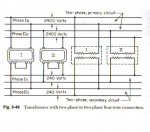If they were 180 off, the net sum of the two would be zero, not 240.
The two 120 volt legs are in phase and additive. They both reach + 120 volts at the same time. If they were 180 degrees shifted, one leg would be + 120 at the exact same time the other was - 120. If you plotted the three wave forms, you would see that the two 120 volt waves occupy the same space in a two dimensional plane as represented by an oscilloscope. If they were 180 off, both 120 volt waves would be visible, but mirror images of each other (which isn't the case).
Simple answer from another forum:
You said:
Quote:
"Let me assure you if you take an oscilloscope and measure the two 120volt legs you can see that they are 180 degrees out of phase and that they are two distinct phases."
For a residential panel this is very true. There is a reason that it is true. There is two different ways to achieve this. One is to center tap one phase. This will give you two sine waves that are 180 degrees out of sink. The other is to use two transformers.
Think about three people standing side by side. The one on the left is person (A) the one in the middle is person (N) and the one on the right is person (B).
Now person (A) walks 120 steps to the left and person (B) walks 120 steps to the right. Both (A) and (B) are 120 steps from person (N) but (A) is 240 steps from (B).
Now let?s look at a delta transformer. It is drawn as a triangle with three corners that can be labeled (A), (B) and (C) from (A) to (B) is one phase of the three phases of the delta transformer, thus when it is taped in the center it is 120/240 volt single phase. Only one phase is being used.
When we refer to two phase electrical we are referring to two phases that are 90 degrees out of phase to each other. These will read the same to ground but this will not be doubled when reading phase to phase as in the residential panel.
Let?s say that the polyphase circuit (two phase) is 120 volts to ground for each phase then the voltage between the two phases would be about 170 volts.


